Southwark Cathedral
Southwark Cathedral (/ˈsʌðərk/)[1] or The Cathedral and Collegiate Church of St Saviour and St Mary Overie, Southwark, London, lies on the south bank of the River Thames close to London Bridge. It is the mother church of the Anglican Diocese of Southwark. It has been a place of Christian worship for more than 1,000 years, but a cathedral only since the creation of the diocese of Southwark in 1905.
| Southwark Cathedral | |
|---|---|
| Cathedral and Collegiate Church of St Saviour and St Mary Overie | |
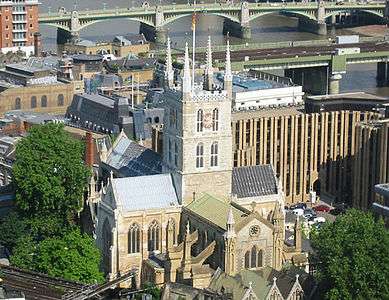 | |
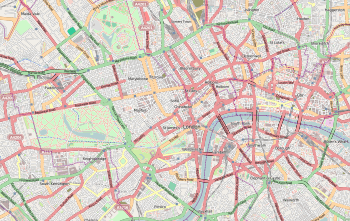 Southwark Cathedral Shown within Central London | |
| Location | Southwark London, SE1 |
| Country | England |
| Denomination | Church of England |
| Website | cathedral.southwark.anglican.org |
| Architecture | |
| Heritage designation | Grade I listed building |
| Designated | 2 March 1950 |
| Style | Gothic, Gothic Revival |
| Years built | 1106–1897 |
| Administration | |
| Diocese | Southwark (since 1905) |
| Province | Canterbury |
| Clergy | |
| Bishop(s) | Christopher Chessun |
| Dean | Andrew Nunn |
| Subdean | Michael Rawson (Canon Pastor) |
| Precentor | [vacant] |
| Succentor | [vacant] |
| Canon Chancellor | Mandy Ford (Director of Discipleship and Ministry) |
| Canon Missioner | Jay Colwill (Director of Mission and Evangelism) |
| Canon Treasurer | Leanne Roberts (Director of Vocations and DDO) |
| Curate(s) | David Adamson |
| Laity | |
| Director of music | Ian Keatley |
| Organist(s) | Stephen Disley |
| Verger | Paul Timms, Simon Gutwein, James Collins, Robert Biden |
Between 1106 and 1538 it was the church of an Augustinian priory, Southwark Priory, dedicated to the Virgin Mary (St. Mary's – over the river). Following the dissolution of the monasteries, it became a parish church, with the new dedication of St Saviour's. The church was in the diocese of Winchester until 1877, when the parish of St Saviour's, along with other South London parishes, was transferred to the diocese of Rochester.[2] The present building retains the basic form of the Gothic structure built between 1220 and 1420, although the nave is a late 19th-century reconstruction.
History
Legendary origins
The 16th-century London historian John Stow recorded an account of the origins of the Southwark Priory of St Mary that he had heard from Bartholomew Linsted, who had been the last prior when the priory was dissolved.[3] Linsted claimed it had been founded as a nunnery "long before the [Norman] Conquest" by a maiden named Mary, on the profits of a ferry across the Thames she had inherited from her parents. Later it was converted into a college of priests by "Swithen, a noble lady". Finally in 1106 it was refounded as an Augustinian priory.
The tale of the ferryman's daughter Mary and her benefactions became very popular, but later historians tried to rationalise Linsted's story. Thus the author of an 1862 guidebook to the then St Saviour's church suggested it was probable that the "noble lady" Swithen had in fact been a man – Swithun, Bishop of Winchester, from 852 or 853 until his death in 863.[4]
In the 20th century this identification was accepted by Thomas P. Stevens, Succentor and Sacrist, and later Honorary Canon, of Southwark Cathedral, who wrote a number of guidebooks to the cathedral, and a history that was revised and reprinted many times. He went on to date the foundation of the supposed original nunnery to "about the year 606", although he provided no evidence to support the date.[5] Although recent guidebooks are more circumspect, referring only to "a tradition", an information panel at the east end of the cathedral still claims that there had been "A convent founded in 606 AD" and "A monastery established by St Swithun in the 9th century".
It is unlikely that this minster pre-dated the conversion of Wessex in the mid-7th century, or the foundation of the "burh" c. 886. There is no proof for suggestions that a convent was founded on the site in 606 nor for the claim that a monastery was founded there by St Swithun in the 9th century.
Saxon and Norman

The earliest reference to the site was in the Domesday Book survey of 1086, when the "minster" of Southwark seems to have been under the control of William the Conqueror's half-brother, Bishop Odo of Bayeux.
The Old English minster was a collegiate church serving an area on the south side of the Thames. In 1106, during the reign of Henry I it became an Augustinian priory, under the patronage of the Bishops of Winchester, who established their London seat Winchester Palace immediately to the west in 1149. A remaining wall of the palace refectory, with a rose window, survives in Clink Street.
The Priory was dedicated to the Virgin Mother as 'St Mary' but had the additional soubriquet of "Overie" ("over the river")[6] to distinguish it from the many churches in the City of London (on the opposite bank of the Thames) with the same name.
Some fragments of 12th-century fabric survive.[7] The church in its present form, however, dates to between 1220 and 1420, making it the first Gothic church in London.
Gothic reconstruction
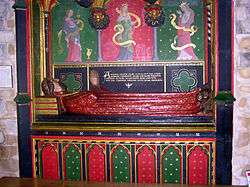
The church was severely damaged in the Great Fire of 1212. Rebuilding took place during the thirteenth century, although the exact dates are unknown.[8] In its reconstructed state – the basic layout of which survives today – the church was cruciform in plan, with an aisled nave of six bays, a crossing tower, transepts, and a five bay choir. Beyond the choir stood a lower retrochoir or Lady chapel, the form of which can also be interpreted as group of four chapels with separate gabled roofs, two opening from the choir, and two from each aisle.[9]
There was a chapel dedicated to Mary Magdalen, for the use of the parishioners, in the angle between the south transept and the choir,[10] and another chapel was later added to the east of the retrochoir.[8] This was to become known as the "Bishop's chapel" as it was the burial place of Lancelot Andrewes.[11]
In the 1390s, the church was again damaged by fire, and in around 1420 the Bishop of Winchester, Henry Beaufort, assisted with the rebuilding of the south transept and the completion of the tower.
During the 15th century the parochial chapel was rebuilt, and the nave and north transept were given wooden vaults[8] following the collapse of the stone ceiling in 1469.[10] Some of the carved bosses from the vault (destroyed in the 19th century) are preserved in the cathedral.[12][13]
The 14th-century poet John Gower lived in the priory precinct and is entombed in the church, with a splendid memorial, with polychrome panels.[14]:58–60 There is also a recumbent effigy of a knight in timber (rather than brass or stone) and it is suggested by the church that this dates from the 13th century. If so then this is one of the oldest such memorials and some credence can be given to the suggestion by its lack of heraldic emblems.
16th and 17th centuries
_by_Claes_Van_Visscher.jpg)
In around 1520 the Bishop of Winchester, Richard Foxe, carried out a programme of improvement, installing a stone altar screen, a new west doorway with a window above[15] and a new window in the east gable of the choir.[16]
Along with all the other religious houses in England, the priory was dissolved by Henry VIII, being surrendered to the Crown in 1540. The receiver in charge of dissolving St Marie Overie was William Saunders.[17] In that year St Mary Overie received the new dedication of St Saviour and became the church of a new parish, which combined those of St Mary Magdalen (the attached parochial chapel) and the nearby church of St Margaret, which was deconsecrated. The parishioners leased the priory church and rectory from the Crown until 1614, when they purchased the church outright for £800.[18]
During the reign of Queen Mary heresy trials were held in the retrochoir. In January 1555, six high-ranking clergymen, including the former Bishop of Gloucester, John Hooper, were condemned to death there.[18]
As the parish church for the Bankside area, St Saviour's had close connections with the great Elizabethan dramatists. William Shakespeare's brother, Edmund, was buried there in 1607. His grave is unmarked, but a commemorative stone was later placed in the paving of the choir. The Cathedral instituted a festival to commemorate this cultural history in the 1920s which endured into the late 20th century.
There is a large stained glass window dedicated to William Shakespeare, depicting scenes from his plays, at the base of which is an alabaster statue representing the playwright reclining, holding a quill.[19][20][21] Two dramatists, John Fletcher and Philip Massinger were buried in the church. Along with Edward Alleyn they were officers and benefactors of the parish charities and of St Saviour's Grammar School.
John Harvard was born in the parish and was baptised in the church on 29 November 1607. He is commemorated by the Harvard Chapel in the north transept, [22] paid for by Harvard University alumni resident in England. His father, Robert, a local butcher and inn-holder, was a business associate of Shakespeare's family and a parochial, school, and church officer with the playwright's colleagues.
The connection with the bishops of Winchester continued after the Reformation. Lancelot Andrewes, bishop of Winchester until his death in 1626, and a contributor to the Authorized Version of the Bible,[23] was buried in a small chapel at the east end that afterwards became known as the "Bishop's Chapel". After the destruction of the chapel in 1830, his tomb was moved to a new position, immediately behind the high altar.[24]
It was from the tower of St Saviour's that the Czech artist Wenceslas Hollar drew his Long View of London from Bankside in 1647, a panorama which has become a definitive image of the city in the 17th century.
19th century
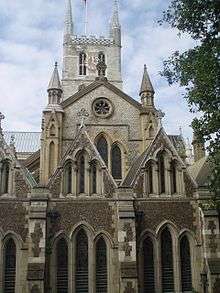
By the early 19th century the fabric of the church had fallen into disrepair. All the medieval furnishings were gone, and the interior was as Francis Bumpus later described it, "pewed and galleried to a fearful extent."[25] Between 1818 and 1830, the tower and choir were restored by George Gwilt Jun.[8] In his efforts to return the church to its thirteenth-century appearance, Gwilt removed the early sixteenth-century windows at the east end of the choir and, lacking firm evidence as to the original design, substituted an elevation of his own invention, with three lancet windows, and a circular one in the gable above.[24] The transepts were restored, less sympathetically, by Robert Wallace.[8] The Bishop's Chapel and parochial chapel were removed, but plans for the demolition of the retrochoir were averted, and it was restored by Gwilt in 1832.
At a vestry meeting held in May 1831 it was decided to remove the nave roof, which had become unsafe, leaving the interior open to the weather, and to hold all future services in the choir and transepts.[26] In 1839, the roofless nave was demolished to within seven feet of the ground,[27] and rebuilt to a design by Henry Rose.[8]
The new nave was at a higher level than the surviving mediaeval eastern part, and closed off from it by a glazed screen. It had a plaster vault carried on iron columns, and a wooden gallery around three sides.[28] It was widely criticised, notably by Pugin who wrote "It is bad enough to see such an erection spring up at all, but when a venerable building is demolished to make way for it, the case is quite intolerable."[29]
On the initiative of Anthony Thorold, Bishop of Rochester, the nave was once again rebuilt between 1890 and 1897[27] by Arthur Blomfield, in a manner intended to recreate its 13th-century predecessor as accurately as possible, and to preserve the few surviving mediaeval fragments.[30]
The main railway viaduct connecting London Bridge station to Blackfriars, Cannon Street and Charing Cross stations passes only eighteen metres from the southeast corner of the cathedral, blocking the view from the south side. This was a compromise when the railway was extended along this viaduct in 1852; the alternative was to demolish the building completely to allow a more direct passage for the line.
Since 1900
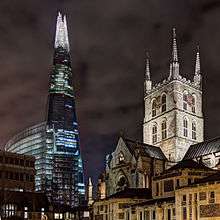
The collegiate parish church of St Saviour was designated as a cathedral in 1905 when the Church of England Diocese of Southwark was created. The nearby early-18th-century church of St Thomas became the new cathedral's chapter-house.[31]
The cathedral stands in an area heavily damaged by German bombing during the Second World War. The total number of bombs dropped on Southwark between 7 October 1940 to 6 June 1941 alone was 1,651 High Explosive Bombs and 20 Parachute Mines.[32] On 20 February 1941 it was reported (after being unrestricted by the ministry of information) the cathedral had been damaged by a bomb.[33] Shrapnel damage is still visible on the outside of the building to this day.[34]
There are memorials to Isabella Gilmore and the victims of the Marchioness disaster and monuments to Nelson Mandela and Desmond Tutu. In 2001 Mandela opened a new northern "cloister" on the site of the old monastic one, with a refectory, shop, conference centre, education centre and museum.[35] In 2002, these Millennium buildings received an award for being one of the best new buildings of the year.
On 16 November 1996 the cathedral became a focus of controversy when it hosted a twentieth-anniversary service for the Lesbian and Gay Christian Movement. Jeffrey John, the openly gay[36] Dean of St Albans and former bishop-elect of Reading, was Canon Theologian of Southwark.
After the introduction of civil partnerships and, later, of civil marriage for same-sex couples in England, the Cathedral announced that "same sex couples are welcome to approach the clergy with regard to preparation and prayers when entering a Civil Partnership and for continuing support and counsel within their relationship ... couples approaching the clergy should expect a warm welcome and affirmation".[37] The Cathedral now says, "Southwark Cathedral is an inclusive community where LGBTi+ people are welcomed and affirmed. The clergy would be delighted to help you to prepare prayerfully for your Civil Partnership."[38]
On 18 July 2017 the conservative organisation Anglican Mainstream announced that Southwark Cathedral had held what it described as a 'wedding-style reception' following the civil partnership ceremony of the Revd Dr Helen Orchard, team vicar of St Matthew's, Wimbledon, and the Revd Canon Leanne Roberts, canon treasurer of the cathedral and director of vocations and diocesan director of ordinands for the diocese. The event, which included a celebration of the Eucharist, was attended by the Very Revd Professor Martyn Percy, Dean of Christ Church, Oxford and his wife the Revd Canon Dr Emma Percy, chaplain of Trinity College, Oxford.[39]
Other information
The cathedral is used by London South Bank University for its annual honorary degree ceremony, by Regent's College for its graduation ceremonies, and by King's College London for its medical and dental degree ceremonies, an association stemming from its merger with Guy's and St Thomas' teaching hospitals, St Thomas' having started as an infirmary attached to the Priory of St Mary. The cathedral also hosts the London Nautical School's annual Christmas Carol Service.
There are two other cathedrals in Southwark: the Roman Catholic St George's Cathedral Southwark and the Greek Orthodox St Mary's at Camberwell New Road.
.jpg)
Southwark Cathedral is also known for being the home to Doorkins Magnificat, a grey female cat who began visiting the cathedral in 2008 as a stray looking for food and shelter. She has since made the Cathedral her permanent home and is often found curled up beneath a radiator or prowling the aisles. She became known as a local celebrity and has met both the Mayor of London and Her Majesty Queen Elizabeth II on formal visits to the cathedral. Doorkins features in the specially-written children's book ‘Doorkins The Cathedral Cat’ which can be bought from the cathedral shop, and in 2018 was immortalised with her very own stone gargoyle which is positioned inside the cathedral.
Dean and chapter
As of 8 February 2019:[40]
- Dean – Andrew Nunn (since 21 January 2012 installation)[41][42]
- Sub Dean and Canon Pastor, and Minister-in-Charge, St Hugh's, Bermondsey – Michael Rawson (since December 2014)
- Canon Precentor – Gilly Myers (since 9 September 2012 installation)[43]
- Diocesan Director of Discipleship and Ministry & Canon Chancellor – Mandy Ford (since September 2014)
- Diocesan Director of Ordinands and of Vocations & Canon Treasurer – Leanne Roberts (since 11 September 2011 installation)[44]
- Diocesan Director of Mission and Evangelism & Canon Missioner – Jay Colwill (since 15 April 2018 installation)[45]
Other clergy:
- Succentor (Minor Canon) — Rachel Young (since January 2017)
- Curate, and at St Hugh's, Bermondsey — David Adamson
Cathedral choirs
Main Cathedral Choir
The Cathedral Choir is supported financially by the St Olave's & St Saviour's Schools Foundation, which stems from the two parochial schools set up in the 1560s which still hold their commemoration and annual services at the cathedral as their 'foundation' church.[46] As the cathedral does not have a choir school, the boys and girls of the Cathedral Choir are drawn from schools throughout London and surrounding areas. Girls are usually admitted to the choir between the ages of ten and eleven, and boys between the ages of seven and ten.[47] There are six Lay Clerks in the Cathedral Choir and up to six Choral Scholars. Three of the Lay Clerks are supported by endowments from The Ouseley Trust, the Vernon Ellis Foundation, and the Friends of Cathedral Music.
The Cathedral Choir performed the music for the television series Mr. Bean.
Former choristers of Southwark Cathedral include David Gedge, who served as Organist of Brecon Cathedral from 1966 until 2007,[48][49][50][51] Richard Marlow, who subsequently directed the choir at Trinity College, Cambridge, and Chuka Umunna, former Member of Parliament for Streatham and formerly Shadow Secretary of State for Business, Innovation and Skills.[52][53]
Ernest Lough, who later made a celebrated recording of O for the Wings of a Dove with the choir of the Temple Church under George Thalben-Ball, auditioned unsuccessfully for a position as chorister at Southwark Cathedral.[54]
Both Alan Young and Jonathan Darbourne, Hammerstein Chanters (head choristers) between 1999 and 2000, were also trebles at English National Opera.[55] Darbourne, in particular, is known for critically acclaimed performances as Miles in Britten's The Turn of the Screw at the East London Theatre on Well Street (now Ensign Street) and as one of the three Child-Spirits in Mozart's The Magic Flute at the London Coliseum. Young performed Harry in Britten's Albert Herring, Paris in Tippet's King Priam, and John (silent role) in Britten's Peter Grimes. Rollo Armstrong also used Young's recorded vocals for Dusted's single Always Remember to Respect and Honour Your Mother, which reached no. 19 in the UK single charts.[56]
Merbecke Choir
In 2004 the Cathedral founded the Southwark Cathedral Merbecke Choir. It is intended to be the place both for boys and girls who leave the Cathedral Choirs and also other young singers who wish to maintain their sight-reading skills acquired as choristers and explore a wide range of repertoire under expert tuition.
The choir sings Compline on the 4th Sunday of each month and performs a seasonal concert of music each term. It also sings for livery companies in the City of London and for other organisations. In 2006 it performed as part of the Queen's Christmas Broadcast, which was recorded at the cathedral.
The Choir is named after the Tudor composer, John Merbecke (1510–1585), who wrote one of the most popular settings of the Book of Common Prayer Communion Service. In 1543 Merbecke and three other companions were tried for heresy in the retrochoir at Southwark. He was found guilty and condemned to death, but his sentence was commuted by Stephen Gardiner, Bishop of Winchester, who decided that, as a mere musician, Merbecke "knew no better".
Thursday Singers
The Thursday Singers are made up of people from the local community. There is no audition. They sing for Festival Eucharists which fall on a weekday. They also sing one service of Choral Evensong most terms and lead the singing at the Cathedral's Carol Sing-In before Christmas.[57]
Organ
.jpg)
The Cathedral's main organ was built by Lewis & Co. of Brixton, and completed in 1897. Thomas Christopher Lewis, the company's founder, was renowned for building instruments that had a bright, vibrant tone which, in part, was due to his use of low wind pressures. Consequently, he was somewhat out of step with the trend at the time, which was tending towards high wind pressures and rather thicker tone. The instrument's action was, and is, electro-pneumatic with slider chests, and the main case was designed by Arthur Blomfield.
Apart from routine maintenance, the instrument remained untouched until 1952, when Henry Willis & Sons undertook a major rebuild, during which the wind pressures were increased. The balanced Swell pedal and the hitch-down Solo pedal were replaced by Willis's Infinite Speed and Gradation pedals. The Choir organ – which had been housed in front of the Swell – was relocated to the north side, and a new console was installed adjacent to it (the original console was on the south side). The Choir organ's Flauto Traverso was replaced by a Nazard, and a Tierce was provided on a new slider. A number of new couplers were also provided and the Violon unit (32'-16'-8') was extended by 12 pipes to create a Viola 4'.
Some years after the rebuild it was thought that the Willis changes, though well intentioned, detracted too much from the original concept, so it was decided to restore the instrument to the Lewis specifications. The Durham-based firm of Harrison and Harrison was engaged, and the work was carried out in two stages. In 1986, the electrics were renewed, and although the Willis console was retained, it was given a solid state action with eight memory levels for the combination pistons and four for the Crescendo pedal. Also, the Willis swell pedals were replaced by balanced pedals.[58]
In 1991, the main work was undertaken, including the re-voicing of the stops on Lewis's original wind pressures. A Lewis Flauto Traverso rank was obtained for the Choir organ, to replace the one discarded by Willis, and the Nazard and Tierce were removed – meaning that the Great organ's Octave Quint is now the instrument's only mutation register. The two prepared for drawstops on the Pedal were also disposed of. Thus, the stop list is now as Lewis left it, except for the Viola 4' which was retained because it was a gift in memoriam.[58]
Former organists of Southwark Cathedral have included E. T. Cook, who was known for his lunchtime organ broadcasts on the BBC, and the organ builder Ralph Downes.
|
|
|
|
| ||||||||||||||||||||||||||||||||||||||||||||||||||||||||||||||||||||||||||||||||||||||||||||||||||||||||||||||||||||||||||||||||||||||||||||
See also
- St Paul's Cathedral – the Anglican cathedral in the neighbouring Diocese of London
- St George's Cathedral, Southwark – the Roman Catholic cathedral in the Archdiocese of Southwark
General:
- List of churches and cathedrals of London
- List of cathedrals in the United Kingdom
- Architecture of the medieval cathedrals of England
- English Gothic architecture
- Church of England
References
- "Southwark", in The Columbia Lippincott Gazetteer of the World (1952), New York: Columbia University Press.
- Worley 1905, p. 34.
- Stow, John (1908), Kingsford, C. L. (ed.), A Survey of London, 2, Oxford: Clarendon Press, p. 56
- Benson, Samuel (1862), A Guide to St Saviour's Church, London: W. Drewett, p. 5
- Stevens, T. P. (1930), Southwark Cathedral 606–1930, London: Sampson Low & Co., p. 11
- Our History: Southwark Cathedral. Copyright 2017. Access date 5 April 2019.
- Cherry & Pevsner 1990, p. 566.
- Cherry & Pevsner 1990, p. 564.
- Bumpus 1930, p. 379–80.
- Worley 1905, p. 17.
- Worley 1905, p. 29.
- Roof bosses, Southwark Cathedral, London. Historic England website. Access date: 5 April 2019.
- Nave: Roof Bosses. Archived version of Diocese of Southwark website 10 December 2004. Access date: 5 April 2019.
- John H. Fisher (1964). John Gower: Moral Philosopher and Friend of Chaucer. New York University Press. ISBN 978-0814701492.
- Worley 1905, p. 18–9.
- Worley 1905, p. 30.
- Sobecki 2015, pp. 925–932..
- Worley 1905, p. 22.
- Sandra Alvarez, '10 Things to See at Southwark Cathedral', Medievalists.net. Access date: 5 April 2019.
- 'Literary London – Shakespeare in Southwark Cathedral', Footprints of London: Where Londoners Walk. Posted: 22 September 2014. Access date: 5 April 2019.
- William Shakespeare - Southwark Cathedral - London, UK. - Statues of Historic Figures on Waymarking.com. Posted 29 June 2016. Access date: 5 April 2019.
- Worley 1905, p. 84.
- Worley 1905, p. 25.
- Worley 1905, p. 43.
- Bumpus 1930, p. 305.
- Worley 1905, p. 32.
- Bumpus 1930, p. 385.
- "XIX.— SATURDAY, MAY 1, 1880. Visit to St. Mary Overie". Transactions of the St. Paul's Ecclesiological Society. 1. 1880.
- Worley 1905, pp. 32–3.
- Worley 1905, pp. 57–8.
- Worley 1905, p. 36.
- "Bombs dropped in Southwark – Bomb Sight – Mapping the World War 2 London Blitz Bomb Census". Bomb Sight.
- "Sarasota Herald-Tribune – Google News Archive Search".
- "Bomb Damage Southwark Cathedral – London". tracesofwar.com.
- "Cathedral crowds greet Mandela". news.bbc.co.uk. BBC News. 28 April 2001. Retrieved 7 April 2019.
- Telegraph, "Gay cleric in line to become bishop in Church of England", 3 July 2010
- "Weddings, Baptisms & Funerals – Worship – Southwark Cathedral". cathedral.southwark.anglican.org. Archived from the original on 18 May 2016. Retrieved 20 June 2016.
- "Weddings, Civil Partnerships and Funerals". cathedral.southwark.anglican.org. Southwark Cathedral. 2017. Retrieved 5 April 2019.
- "Celebration of lesbian civil partnership at Southwark Cathedral (under 'Gay Activism')". anglicanmainstream.org. Anglican Mainstream. 18 July 2017. Retrieved 7 April 2019.
- Southwark Cathedral — The Clergy (Accessed 8 February 2019)
- "Tenth Dean of Southwark announced – What's new – The Diocese of Southwark". anglican.org. Archived from the original on 23 October 2014.
- The Bridge – November 2003, page 3 Archived 17 November 2015 at the Wayback Machine
- "Southwark Cathedral appoints new Precentor – What's new – The Diocese of Southwark". anglican.org. Archived from the original on 14 April 2013.
- "A busy patronal festival for Southwark Cathedral – What's new – The Diocese of Southwark". anglican.org. Archived from the original on 14 April 2013.
- "New Canon Missioner for Diocese of Southwark - The Diocese of Southwark". southwark.anglican.org. Retrieved 25 January 2019.
- see St Olave's Grammar School and St Saviour's and St Olave's Church of England School for Girls.
- "Music and Choirs – Worship – Southwark Cathedral". cathedral.southwark.anglican.org. Archived from the original on 1 October 2016. Retrieved 30 September 2016.
- David Gedge, A Country Cathedral Organist Looks Back (n.p.: David Gedge, 2009).
- Helen Burrows, review of A Country Cathedral Organist Looks Back 1939–1978, in Church Times (2 November 2006). Accessed 18 April 2013.
- W.B. Henshaw, 'David Gedge', Biographical Dictionary of the Organ. Accessed 18 April 2013.
- David M. Cummings, ed., International Who's Who in Music and Musician's Directory 2000/2001 (In the Classical and Light Classical Fields) (17th edn., Cambridge: Melrose, 2000), i, 224.
- 'Chuka Umunna Coy About Leadership Ambitions', Sky News (1 October 2012). Accessed 18 April 2013.
- "Alice Foster, 'Streatham MP Chuka Umunna would be "arrogant" to talk about Labour leadership bid', Streatham Guardian (2 October 2012). Accessed 18 April 2013". Archived from the original on 15 March 2016. Retrieved 24 December 2018.
- Douglas Martin, 'Ernest Lough, Choirboy Whose Voice Endured on Famous Recording, Dies at 88', The New York Times (6 March 2000). Accessed 19 April 2013.
- "Jonathan Darbourne (Counter-tenor) – Short Biography". bach-cantatas.com. Retrieved 24 October 2017.
- "Dusted : Always Remember To Respect And Honour Your Mother (Pt 1) – NME". NME. Retrieved 24 October 2017.
- "Music and Choirs". Southwark Cathedral. Archived from the original on 1 October 2016. Retrieved 21 September 2017.
- A specification of the organ can be found on the National Pipe Organ Register.
Sources
- Bumpus, T. Francis (1930). The Cathedrals of England and Wales. London: T. Werner Laurie.CS1 maint: ref=harv (link)
- Cherry, Bridget; Pevsner, Nikolaus (1990) [1983]. London 2: South. The Buildings of England. Penguin Books. ISBN 0-14-071047-7.CS1 maint: ref=harv (link)
- Sobecki, Sebastian (2015). "Ecce patet tensus: The Trentham Manuscript, In Praise of Peace, and John Gower's Autograph Hand" (PDF). Speculum. 90 (4): 925–959. doi:10.1017/S0038713415002316. hdl:11370/534fae63-f48c-417a-8747-4d673e52131a.
- Worley, George (1905). Southwark Cathedral. Bell's Cathedrals. London: George Bell & Sons. Retrieved 7 October 2011.CS1 maint: ref=harv (link)
External links
| Wikimedia Commons has media related to Southwark Cathedral. |